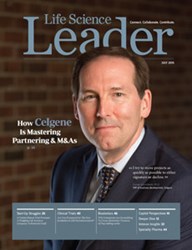Want To Know What Deal Celgene's George Golumbeski Is Most Proud Of?

By Rob Wright, Chief Editor, Life Science Leader
Follow Me On Twitter @RfwrightLSL

From The July 2015 Issue
Read the full magazine article: Celgene: Mastering Partnering & M&As To Build Its Next Generation Of Assets
George Golumbeski, Celgene’s SVP of business development, has been listed as one of the most influential folks in all of biotech, the result of the company’s consistent deal-making success, which is his primary role. When I asked him if he had a deal he was most proud of, he replied, “It’s funny. I was just asked that same question yesterday on a panel in San Francisco. I’m a proud father of two boys. While I am not trying to dodge the question, to me, answering would be similar to telling you which of my sons I am most proud.” According to Golumbeski, he is proud of all the deals — often for different reasons. For example, Abraxis was the first really large M&A where Celgene purposely built contingent value rights (CVR) that were traded on the open market. “We got the deal, and then the drug was approved in pancreatic cancer, the first new treatment to improve survival in pancreatic cancer in 20 or 25 years,” he states. “On the other hand, the Agios deal was the first deal we did in my tenure at Celgene where we put significant money into a very young company, a $130 million up front.” “Almost four years to the day of the deal being signed, they presented remarkable data for a subset of acute myeloid leukemia a disease for which there hasn’t been any solutions.” The Quanticel deal was Celgene’s “first build-to-buy”. Golumbeski said there were stories about nearly all the various deals, but what he is most proud of is the aggregate work done by his BD team, something which would not have been possible without the complete support from Celgene’s board; CEO, Bob Hugin; and all of his colleagues. “I think I’m really most proud of the company and its willingness to take these risks’” he concludes.
